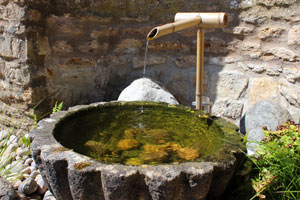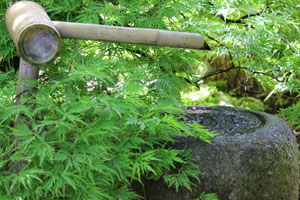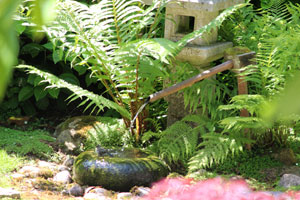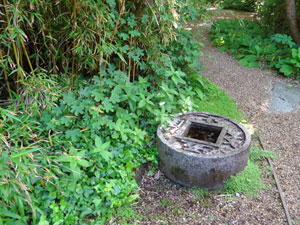Granite Water Basins
Japanese Garden Design

Whether or not you have room for a koi pond or smaller pool, you may like to consider the inclusion of a stone or granite basin, or similar water feature.
In Japan, basins are known as 'Tsukubai', being a common sight in traditional tea gardens and often accompanied by three carefully placed kneeling stones.
History and Uses
These basins were originally placed within ancient temples and religious shrines, being regularly filled with fresh water so that any visitors could wash their hands and mouth, to cleanse and purify themselves before entering. A small bamboo ladle spoon is often placed across the top for this very purpose.

Styles and Shapes
There are numerous different designs available to purchase from specialist Japanese landscape garden suppliers, with the most common being a simple round doughnut ring-like shape with curving sides (Tetsu bachi). Several variations of this shape exist, such as the more spherical 'Teppatsugata' and the taller upright 'Natsu me bachi' versions.
A flat topped, cylindrical basin is another popular alternative, with this design featuring Japanese characters on the top, around the square framed hole filled with water. Named as a 'Zeni bachi' basin, this particular style is design to resemble an ancient oriental coin with a hole in the centre.

Also regularly hand-carved from granite is the 'Kiku bachi' water basin, which is shaped rather like a Lotus flower, with petal shapes around the edge and a defined rim surrounding the water bowl in the centre.
A little more abstract is a square basin or 'Ginkakuji', which features a lattice pattern on its sides and is sometimes covered with a peaked roof made from bamboo slats.
Granite, Stone and Concrete Versions
Many Japanese gardens today utilise natural rock, stone and granite basins as trickling water features, standing them above a hidden reservoir and pumping water into them through a trickling bamboo spout, so that they are constantly overflowing into the tank beneath. The reservoir is easy to hide, since it is topped with a strong, fine mesh, meaning that it can be covered with pebbles, gravel or a slate mulch.

If you find the cost of purchasing a hand-carved granite basin somewhat prohibitive, then it is quite possible to make your own interpretation, using a fine, flexible wire mesh and a plastic flower pot for the central hole. Carefully shape your mesh into a circle and cover this wire with a mixture of cement, sand and sieved peat, which will create a natural stone-like appearance and promote the growth of moss.
As the concrete mix begins to set, after an hour or so, smooth it over with a wet sponge and if necessary, add another layer to ensure that you create an even, symmetrical shape. The holes in the flower pot should be filled with a waterproof silicon sealant or the pot placed within a waterproof plastic bag, with the inside then being painted with a thin concrete layer, so that it blends in with the rest of the homemade Japanese water basin.
 Whether or not you have room for a koi pond or smaller pool, you may like to consider the inclusion of a stone or granite basin, or similar water feature.
Whether or not you have room for a koi pond or smaller pool, you may like to consider the inclusion of a stone or granite basin, or similar water feature.
 Also regularly hand-carved from granite is the 'Kiku bachi' water basin, which is shaped rather like a Lotus flower, with petal shapes around the edge and a defined rim surrounding the water bowl in the centre.
Also regularly hand-carved from granite is the 'Kiku bachi' water basin, which is shaped rather like a Lotus flower, with petal shapes around the edge and a defined rim surrounding the water bowl in the centre. If you find the cost of purchasing a hand-carved granite basin somewhat prohibitive, then it is quite possible to make your own interpretation, using a fine, flexible wire mesh and a plastic flower pot for the central hole. Carefully shape your mesh into a circle and cover this wire with a mixture of cement, sand and sieved peat, which will create a natural stone-like appearance and promote the growth of moss.
If you find the cost of purchasing a hand-carved granite basin somewhat prohibitive, then it is quite possible to make your own interpretation, using a fine, flexible wire mesh and a plastic flower pot for the central hole. Carefully shape your mesh into a circle and cover this wire with a mixture of cement, sand and sieved peat, which will create a natural stone-like appearance and promote the growth of moss.